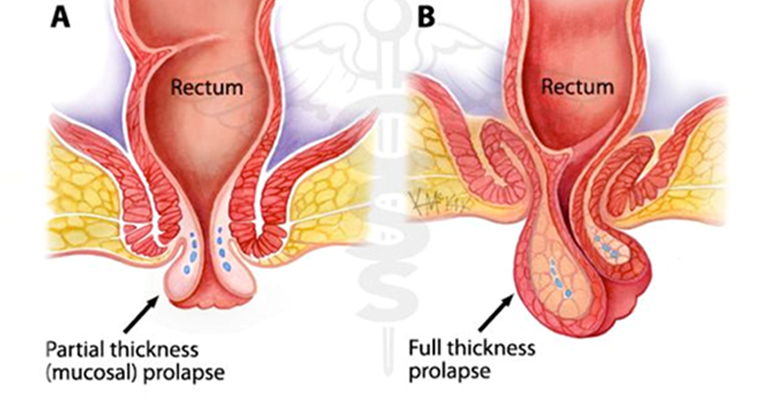What is Rectal Prolapase ?
Rectal Prolapse is when part of your rectum protrudes (sticks out) through youranus. Your anus (back passage) is where your rectum opens onto your skin. A rectal prolapse can be uncomfortable and embarrassing and may affect your daily life.

What are causes of Rectal Prolapse?.
Rectal prolapse can occur as a result of many conditions, including:
- Chronic Constipation or Chronic Diarrhea
- Long-term history of straining during bowel movements.
- Older age.
- Weakening of the anal sphincter.
- Prior injury to the anal or pelvic areas.
- Damage to nerves
- Other diseases, conditions, and infections.
What are the symptoms of Rectal Prolapse?
A person with a prolapsed rectum may feel tissue protruding from the anus and experience the following symptoms:
- Pain during bowel movements.
- Mucus or blood discharge from the protruding tissue.
- Fecal incontinence (inability to control bowel movements)
- Loss of urge to defecate (mostly with larger prolapses)
What are treatment options for Rectal Prolapse?
Nonoperative Management
Generally, a prolapsed rectum can be reduced with gentle digital pressure;. Although no medical treatment is available for rectal prolapse, internal prolapse should always be first treated medically with bulking agents, stool softeners, and suppositories or enemas.
Operative management
Surgical approaches in rectal prolapse can be either perineal or abdominal. A perineal approach (or trans-perineal) refers to surgical access to the rectum and sigmoid colon via incision around the anus and perineum (the area between the genitals and the anus). Abdominal approach (trans-abdominal approach) involves the surgeon cutting into the abdomen and gaining surgical access to the pelvic cavity. Procedures for rectal prolapse may involve fixation of the bowel (rectopexy), or resection (a portion removed), or both. Trans-anal (endo-anal) procedures are also described where access to the internal rectum is gained through the anus itself.
Abdominal procedures
The abdominal approach carries a small risk of impotence in males (e.g. 1-2% in abdominal rectopexy). Abdominal operations may be open or laparoscopic (key hole surgery)
Perineal procedures
The perineal approach generally results in less post-operative pain and complications, and a reduced length of hospital stay
Laproscopic procedures
Recovery time following laparoscopic surgery is shorter and less painful than following traditional abdominal surgery. Rectopexy and anterior resection have been performed laparoscopically with good results.
Perineal rectosigmoidectomy
Perineal rectosigmoidectomy aims to resect (remove) the redundant bowel via the perineum and anchor the lower rectum to the sacrum through fibrosis in the hope of preventing future prolapse.
Delorme Procedures
This is a modification of the perineal rectosigmoidectomy, differing in that only the mucosa and submucosa are excised from the prolapsed segment, rather than full thickness resection.
Anal encirclement (Thirsch procedure)
This procedure can be carried out under local anaesthetic. This procedure is generally reserved for debilitated or other individuals at high anesthetic risk who may not tolerate other perineal procedure
For More about Laparoscopic in Rectal Prolapse, you can reach directly to Dr. Mradul Garg at +91-9560413585
